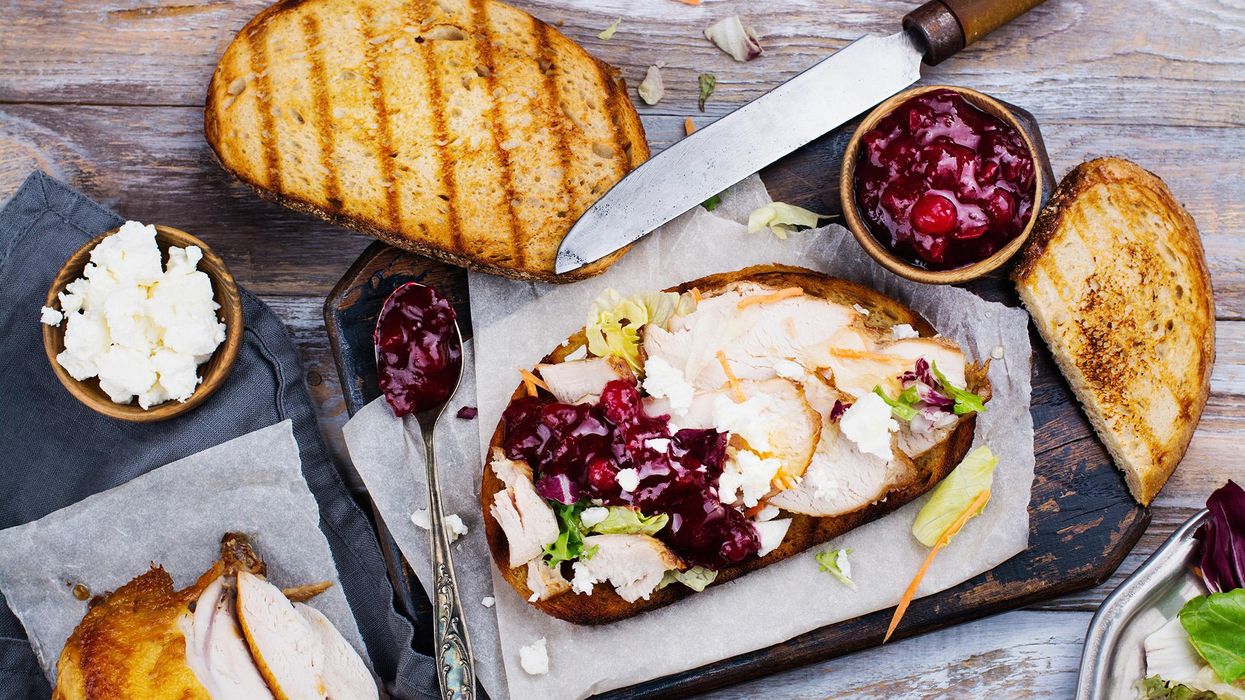(CNN) — For most Americans, planning the Thanksgiving menu is easy. It's a given that turkey — whether purchased raw or fully cooked — will be the centerpiece, even if half the guests have gone vegetarian. Certain family-approved sides and desserts are required to avoid a revolt. And overly generous invitees can be counted on to fill any gap on the table with covered dishes large enough to feed the neighborhood.
The hard part is reining in that bounty.
For those who dread dealing with the aftermath of the feast almost as much as they look forward to the conviviality of the celebration, publisher and TV food personality Christopher Kimball offers this tip: "Make half as many dishes as you think you need. Most of us could trim back our menus a lot, and no one would leave hungry."
That's sage advice — not only for the sake of our pocketbooks but also the planet.
More than a third of our country's food supply goes uneaten, the US Department of Agriculture estimates. Wasted food, according to the US Environmental Protection Agency, is the single largest category of material clogging municipal landfills. As it rots, it emits methane, a powerful planet-warming gas that is far more potent than carbon dioxide.
The holiday season is particularly rough on Mother Nature. A 2018 report by the Center for Biological Diversity notes that, between Thanksgiving and New Year's Day, Americans throw out about 25% more trash than at other times of year. Each Thanksgiving, according to the report, an estimated 200 million pounds of turkey meat, 150 million pounds of vegetable sides and 14 million pounds of dinner rolls produce nearly half a million metric tons of greenhouse gas emissions. That's not counting the fossil fuels burned for cross-country gatherings or the deluge of plastics and other disposals used for serving, cleaning and wrapping.
Kimball is the founder of Christopher Kimball's Milk Street, a Boston-based food media franchise focused on practical home cooking, fresh ingredients and solid technique. That is a solution for coping with rising food costs while striving to be better stewards of the environment. His team's latest effort is the cookbook "Milk Street: Cook What You Have: Make a Meal Out of Almost Anything."
He and other sustainably minded culinary experts shared their personal strategies for celebrating the fall abundance with gratitude for friends, family and the land that made the feast possible.
Less is more
"I stay away from crowded buffet tables," Kimball said in a phone interview. Instead, he favors a more streamlined, family-style menu of turkey, basic mashed potatoes and a couple of sturdy side vegetables from a local farm delivery that can easily be reheated — no salads that will turn to mush by the meal's end.
"I don't dress up my vegetables — I keep them very simple," he said. "I might do roasted, charred brussels sprouts seasoned with an interesting spice mix I make up on the spot, or boiled greens. If there are leftovers, I can fold them into a frittata, mix them in a pasta sauce or add them to a rice bowl."
Rather than roast the turkey whole, Kimball slow-braises the dissected parts in a few inches of stock with some aromatics in a high-sided roasting pan, "because there's nothing worse than a big, gnarly leg that's all dried out." This way he can remove the tender white meat first so that it doesn't overcook while allowing extra time for the tough dark pieces stubbornly clinging to the bone to continue cooking to fall-apart tenderness. "And the pan juices make a really great gravy."
After the meal, he cuts up the bones to make a stock. "It makes so much of a base ingredient to have on hand in the freezer. This is where the pantry comes in and can take you in all sorts of different directions, with huge bursts of flavor like anchovies, chipotles or pomegranate molasses."
This easygoing approach gives him more time to devote to his favorite part of the preparation: baking pies. "I never have to worry about having leftovers with those."
Leftover idea: Toasted pearl couscous with sweet potato and cranberries, a favorite from the Milk Street test kitchen, makes a tasty vehicle for next-day roasted sweet potatoes and tidbits from the cupboards and crisper.
Don't scrap the scraps
Cooking Thanksgiving for a small crew poses its own challenges. Michigan-based food writer Lindsay-Jean Hard said that while her husband always dry-brines a turkey, "this year's bird will be a very small one because my daughter and I are vegetarians, and we know we don't want to have a lot of leftovers."
An avid gardener with a master's degree in urban planning and passion for sustainability, Hard plots out her menu in advance and scales her recipes close to what she knows they'll actually eat. She even looks for ways to incorporate parts of the produce typically destined for the compost bin into family meals.
Some of those no-waste innovations — such as Carrot Top Pesto and Danish Pancakes with Apple Core Syrup — can be found in her 2018 cookbook, "Cooking With Scraps: Turn Your Peels, Cores, Rinds, and Stems into Delicious Meals."
One easy tip to bear in mind when you start cooking your feast: Put away the peeler.
"Once you get in the habit of peeling things it can be easy to go on auto-pilot and keep doing it," Hard said via email. "Take a moment to stop and ask yourself if it's necessary. Carrots don't need to be peeled. Give them a good scrub with a vegetable brush and carry on. Ginger doesn't need to be peeled either. And leaving the apple peels on (ideally organic) means your apple pie will have added color, texture, and nutrients."
Similarly, she added that "it's easy to discard perfectly edible stems — put them to use!" Finely chopped kale or chard stems can be added along with onions while they're sautéing, she said, and finely chopped soft herb stems such as parsley can be added to dishes right along with the leaves.
And don't be afraid to break with tradition. "If everyone insists that it's not Thanksgiving without green bean casserole, but then no one ever eats more than a bite or two, make a half batch this year," Hard advised. "Or skip it entirely, explaining that you're doing it in the name of Mother Earth, and start a new tradition with a green vegetable dish that folks will actually eat."
Leftover tip: Hard added that she does love silky smooth mashed potatoes, so she saves the peels to repurpose in other dishes such as potato peel focaccia.
Think locally, seasonally ... and frugally
Georgia restaurateur, cookbook author and "Top Chef" judge Hugh Acheson is a longtime supporter of local, sustainable agriculture both in his businesses and at home. His Thanksgiving preparations start with a trip to a local farmers market, where he can thank the growers personally for his bounty.
"Everything but the turkey is vegetarian," Acheson said, which ensures everyone who casually congregates around his kitchen island will have plenty to choose from.
Leeks are always on the grocery list for the savory bread pudding he makes every year. Any extras, he said, are great for breakfast the next day, cut in squares and crisped up in butter. The rest of the menu depends on whatever looks best in the bins. "I cook everything pretty simply," he said.
To estimate how much to buy before he begins, "I carefully gaze at a dinner plate and imagine how it should look when it's full," Acheson explained. He uses that mental image to gauge portion sizes, which he multiplies by the number of the guests, allowing for some second helpings and leftovers.
Leftover idea: Here's how Acheson turns leftovers into a turkey avocado sandwich as memorable as the feast.
Divide and conquer
"Thanksgiving is hands down one of the biggest grocery hauls of the year, and to minimize food waste you'll want to first take stock of what you already have in your pantry and fridge before heading off to the market," advised Lisa Bryan, author of "Downshiftology: Healthy Meal Prep Cookbook."
"Take the time to toss out expired goods and organize the items you'll be using in the coming days so they're visible and easily accessible," she said.
Bryan understands that executing a chaos-free Thanksgiving dinner takes practice. She offers detailed guidance on her website for people who are new to the game. She recommends making a grocery list, and organizing it in sections (produce, dairy, dry goods) to make your shopping trip as efficient as possible.
"Our Thanksgiving is usually multiple families and relatives coming together, and after numerous years we've got a great system in place," she wrote via email. "We divvy up the cooking with one person cooking the turkey, a few people in charge of sides, salads and sauces, and I'm usually in charge of desserts — since gluten-free baking is my jam."
Making it a group effort can ease the burden, so long as you have a game plan in place for before, during and after the feast.
Leftover ideas: With turkey leftovers the next day, Bryan said, "you can easily whip up a turkey hash for breakfast, a turkey Cobb salad for lunch, and a turkey casserole for dinner — take your pick!"
The-CNN-Wire
™ & © 2022 Cable News Network, Inc., a Warner Bros. Discovery Company. All rights reserved.


















































